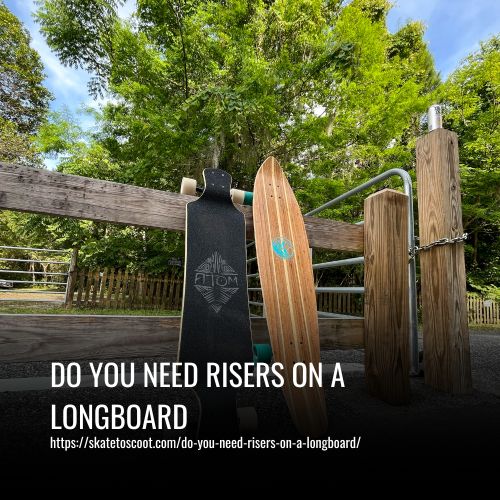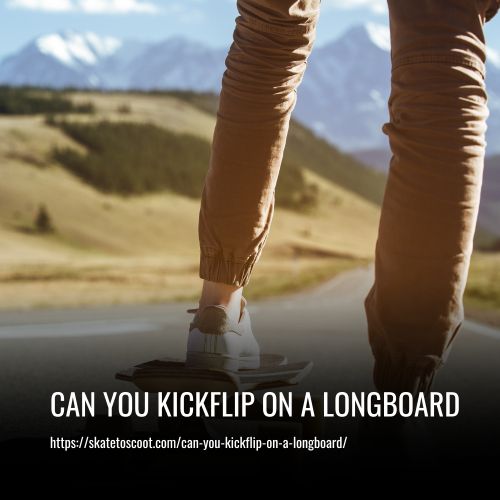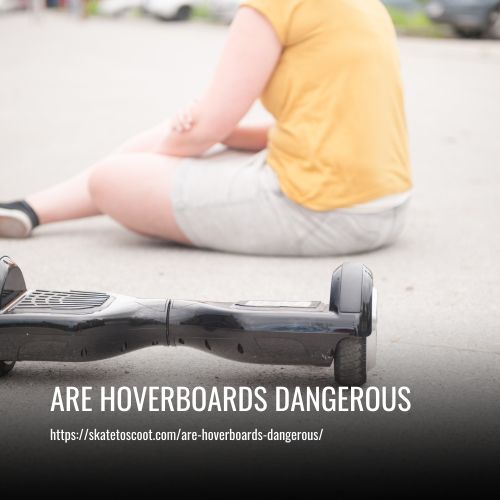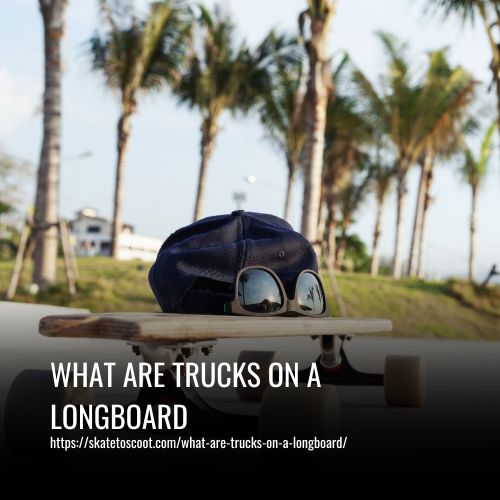As an Amazon Associate we earn from qualifying purchases.
Risers are small accessories that can greatly impact your longboarding experience. They are placed between the deck and the trucks to increase the distance and alter the ride dynamics. By using risers, you can potentially prevent wheel bite and have better control over your board.
However, drop-through longboards usually do not require risers. Skateboards and longboard decks with wheels smaller than 55 mm typically don’t need risers, but even using 1/8″ risers can help prevent hardware from vibrating loose.

The Function of Risers
When it comes to longboarding, risers are crucial components that play a vital role in enhancing the overall performance and ride quality of the board. Let’s explore the various ways in which risers fulfill their function and impact the performance of a longboard.
1. Preventing Wheel Bite and Enhancing Stability
First and foremost, the main purpose of using risers on a longboard is to increase the distance between the deck and the trucks. By elevating the deck higher from the ground, risers provide additional clearance for larger wheels, preventing wheel bite and ensuring a smoother and more versatile ride. Moreover, the increased distance between the deck and the trucks can also have a significant impact on the ride and performance of a longboard, altering the board’s center of gravity and resulting in a more stable and controlled ride.
2. Comfort and Customization
Using risers on a longboard also offers additional benefits such as damping vibrations, absorbing shocks, and customizing the setup to meet specific needs. Different thicknesses and angled designs of risers allow riders to fine-tune their setups to cater to individual preferences and riding styles, ultimately contributing to a more enjoyable and versatile riding experience.
Factors to Consider When Choosing Longboard Risers
When selecting risers for your longboard, it is important to consider several key factors to ensure they align with your preferences and enhance your riding experience.
1. Personal Preferences and Riding Style
Consider your personal preferences and riding style when choosing risers. Determine whether you prioritize stability or maneuverability and select risers that complement your desired ride characteristics.
2. Impact on Stability and Maneuverability
Risers significantly affect the stability and maneuverability of your longboard. Increasing the distance between the deck and trucks enhances stability, while decreasing it improves maneuverability. Find the right balance based on your riding style and preferences.
3. Height and Center of Gravity
Risers alter the height of your longboard. Higher risers provide clearance for larger wheels, better shock absorption, and a more comfortable ride. However, excessive height can compromise stability. Find the optimal height for your needs.
4. Types of Risers
Different materials, such as hard plastic and soft rubber, offer varying characteristics. Hard plastic risers provide stability, while soft rubber risers absorb vibrations. Consider the benefits of each material and choose accordingly.
By considering these factors, you can make an informed decision about the risers that best suit your longboarding needs. Customizing your setup with the right risers enhances your stability, maneuverability, and overall riding experience.
Types of Riser Pads
Riser pads are an essential component for cruisers and longboarders, providing extra height between the skateboard deck and the truck. They come in various sizes, angles, and hardness levels, catering to different riding styles and preferences. While skateboarders typically only need standard risers, longboarders and cruisers have a wide range of options to choose from.
Wedge riser pads, for example, have an angled design that can alter the angle of the trucks, effectively changing the board’s turning response. This can be beneficial for riders looking to fine-tune their setup for specific riding styles or terrain. Angled riser pads, on the other hand, provide a similar effect but with a more gradual incline.
In terms of shape, riser pads can come in rectangular or round designs. Rectangular riser pads offer a larger surface area of contact between the deck and the trucks, providing added stability and reducing the chance of stress cracks. Round riser pads, on the other hand, are ideal for riders who prioritize maneuverability and a responsive ride.
1. Standard Riser Pads
Standard riser pads are commonly used in skateboard setups to provide extra height between the skateboard deck and the truck. They are available in various sizes, with the larger ones being more suitable for longboards and cruisers rather than regular skateboards.
The thickness of standard riser pads typically ranges from 1/8″ to 1/4″, although the latter is becoming increasingly rare. These riser pads can help reduce the chance of wheel bite and stress cracks, enhancing the overall ride quality. While standard riser pads may not offer as many customization options as other types of riser pads, they provide a simple and straightforward solution for riders looking to add some extra clearance and stability to their setup.
2. Wedged or Angled Riser Pads
Wedged or angled riser pads are an essential component for cruisers and longboards. Unlike standard riser pads, which are flat, wedged riser pads come with an angled shape. The main purpose of these pads is to enhance the turning radius and provide a superior carving experience.
The angle of the riser pads determines the level of responsiveness of your board. By adjusting the angle, you can customize the turning capabilities to suit your riding style and preferences. This increased responsiveness is particularly beneficial for riders who enjoy carving and making quick turns.
In addition to varying angles, wedged riser pads are also available in different sizes and durometers. Softer pads offer deeper carving and quickly snap back into shape, allowing for a more dynamic and controlled riding experience.
3. Shock Pads
Shock pads are a helpful accessory for longboards and skateboards as they serve two important purposes. Firstly, they effectively reduce vibrations and impacts, providing a smoother and more comfortable ride. This can be particularly beneficial when riding on rough surfaces or uneven pavement. Additionally, shock pads play a crucial role in preventing pressure cracks near the area where the trucks’ base plates are attached to the deck.
Shock pads are available in two standard thicknesses – 1/16″ and 1/8″. While it is possible to stack multiple shock pads, it is generally recommended to opt for larger standard risers instead. This is because using bigger risers provides a more stable and secure setup, ensuring better weight distribution and minimizing the risk of damage over time.
Riser factor
Risers are an important factor to consider when setting up a longboard. They are small, hard plastic pads that fit between the skateboard deck and the trucks. Risers come in different shapes and sizes, and they serve multiple purposes. In this article, we will explore the importance of risers on a longboard and why you may need them for your riding style and preferences.
1. Deck Shape
The shape of your longboard deck plays a significant role in determining the need for risers. Some decks have a design where they sit on top of the wheels, with the width of the deck covering a large portion of the wheels. This kind of deck shape can potentially result in wheel bite, especially when leaning into turns.
In contrast, other decks are designed with large wheel cutouts, allowing the wheels to mostly stick out from the sides of the deck. These decks provide good clearance and are less prone to wheel bite, typically not requiring risers unless you are running huge wheels.
Additionally, the presence of wheel wells or wheel flares on a longboard deck can increase wheel clearance and further reduce the risk of wheel bite, minimizing the need for risers. Overall, the shape of your longboard deck greatly influences the potential necessity of risers in your setup.
| DECK / WHEELS | 65mm Fat Free | 70mm 4President | 75mm In Heat | 80mm Kegel | 85mm Caguama |
| Coyote 34″ | 1/16″ | 1/8″ | 1/4″ | 3/8″ | 1/2″ |
| Poke 30.75″ | 1/16″ | 1/16″ | 1/16″ | 1/16″ | 1/8″ |
| Icarus 38.4″ | 1/16″ | 1/16″ | 1/16″ | 1/16″ + bushings | 1/16″ + bushings |
| Dervish Sama 42.8″ | 1/16″ | 1/16″ | 1/16″ | 1/16″ + bushings | 1/16″ + bushings |
2. Mount Style
In a top mount setup, the trucks are attached directly to the bottom of the deck, and the rider’s feet sit on or near the truck mounts. This configuration increases leverage in turns and results in more deck lean. However, it also increases the risk of the deck touching the wheels, potentially causing wheel bite. To prevent this, risers may be needed to add extra height and provide clearance between the deck and the wheels.
On the other hand, drop-through setups involve mounting the trucks through holes cut inside the deck. The foot platform is positioned between the truck mounts, reducing leverage and deck lean. Additionally, drop-through decks often feature large cutout shapes, further minimizing the need for risers.
3. Deck Flex & Wheelbase
Deck flex and wheelbase are important factors to consider when determining the need for risers on a longboard. The amount of flex in a deck affects the risk of wheel bite, which occurs when the deck touches the wheels in hard turns. Flexier decks, with more bend and torsional flex, increase the chance of wheel bite.
For example, a flexy deck like the Loaded Chinchilla will have a greater chance of wheel bite compared to a stiffer deck like the Poke, assuming all other factors remain the same (rider weight, deck size, wheel, and truck setup).
4. Rider Build
Rider build plays a significant role in determining the need for riser pads on a longboard. The weight of the rider can impact the amount of flex experienced in the deck, which can increase the chances of wheel bite. Heavier riders are more likely to experience wheel bite as the deck deforms and rubs against the wheels.
In such cases, adding hard riser pads can help increase wheel clearance and prevent potential damage caused by wheel bite. Additionally, adjusting the trucks by using harder bushings or tightening them can also provide some relief from wheel bite.
Another factor to consider is the rider’s shoe size. Those with larger shoe sizes may experience “shoe bite,” where their feet extend beyond the width of the deck and come into contact with the ground during tight turns. To address this issue, adding riser pads of 1/4″ or 1/2″ can increase the distance between the feet and the ground, reducing the chances of a shoe bite.
5. Wheel Size
When it comes to deciding whether or not you need risers on your longboard, one of the key factors to consider is the size of your wheels. Larger wheels have a greater chance of rubbing against the bottom of your longboard deck during tight turns, which can lead to wheel bite.
For example, if you are trying to fit huge 105mm wheels onto your deck, you may experience wheel bite even with riser pads. In some cases, additional adjustments such as playing with washers and bushings may be necessary to prevent wheel bite completely.
To give you an idea of the recommended riser sizes for specific setups, Loaded’s longboard setup guide suggests using 1/2″ risers for certain combinations of Loaded decks and Orangatang wheels.
6. Truck Looseness
Truck looseness refers to the degree of freedom or play in the movement of your skateboard or longboard truck. It can directly affect the likelihood of experiencing wheel bite, which is when the wheels come into contact with the deck during sharp turns or maneuvers.
Running looser trucks will increase the deck lean and the chance of wheel bite, assuming all the other factors remain the same. This means that if your trucks are not tightened enough, the deck will lean more, bringing the wheels closer to the deck, and increasing the risk of wheel bite.
To combat wheel bite without necessarily needing thicker risers, there are a few adjustments you can make. Firstly, you can opt for harder bushings, which will offer more resistance and limit the truck’s movement, reducing the chances of wheel bite. Additionally, you can tighten the kingpin nut on your trucks, which will also restrict the truck’s movement and decrease the likelihood of wheel bite.
7. Riding Style
The type of riding style you engage in will greatly affect whether or not you need risers on your longboard. Different riding styles require different setups to optimize performance and prevent wheel bite.
- Cruising / Pushing: For comfortable cruising and distance pushing, a lower ride is desirable. Thin “shock pad” risers can be used for some vibration absorption, but the size of your wheels should also be considered. If you opt for larger wheels (e.g., 75 to 85mm), such as the Orangatang Caguamas for distance pushing, you will likely need risers.
- Carving: When it comes to carving, rider pads can be used to increase the distance between your deck and wheels, preventing wheel bite. The size of the risers needed will depend on your deck, setup, weight, and other factors. Wedged risers can also be helpful in improving turn radius and stability during hard carves.
- Freeride / Downhill: If you’re learning to slide, a lower deck makes it easier, so using thin risers is advisable to prevent wheel bite. Typically, regular slides do not require extreme deck lean, so wheel clearance is usually not an issue. However, downhill riders often use risers for higher ground clearance at high speeds, preventing deck grinding against the road in toe-side drifts. Taller risers can also enhance cornering power and stability at high speeds.
- Pumping & Slalom: In pumping and slalom disciplines, angled risers can be used to alter the steering angle of your trucks. With an increased turn in the front truck and a reduced turn in the rear truck, you can generate speed by pumping through turns. This setup allows for more grip and stability.
- Freestyle: Freestyle setups typically have smaller and harder wheels (55 to 62mm), so risers are generally not required for clearance. However, hardcore tricks involving hard landings and leaning standard wheel clearance may be put to the test in extreme situations. Small risers can also allow for a steeper board angle during kick tricks, providing more leverage and pop on the tail, making certain tricks easier to perform.
Consider your riding style and the specific requirements of your setup to determine whether or not risers are needed on your longboard. Experimenting with different riser sizes and setups can help you find the perfect combination for your riding style.
FAQs
Risers are small pads that are placed between the longboard deck and the trucks. They are used to increase the distance between the deck and the wheels.
It depends on your personal preference and how you plan to use your longboard. Risers can help prevent wheel bite and provide a smoother ride, especially when using larger wheels. They can also affect the responsiveness and stability of the board.
Risers increase the distance between the deck and the wheels, reducing the likelihood of the wheels coming into contact with the deck during turns or maneuvers that put pressure on the board.
The size of risers you need will depend on the size of your wheels and your riding style. Generally, larger wheels will require thicker risers to prevent wheel bite.
Yes, risers can be used with any type of longboard, including drop-through, top mount, and double drop longboards.
No, risers are not necessary for all riders. It ultimately comes down to personal preference and the specific setup and style of riding. Some riders may find that they do not need risers for their longboard.
Conclusion:
Whether you’re a beginner or a seasoned longboarder, the decision to use risers ultimately comes down to personal preference and the type of riding you enjoy. While risers can offer some benefits in terms of stability and clearance, they may not be necessary for everyone.
So, before you make a decision, consider your riding style, terrain, and comfort level. Remember, the most important thing is to have fun and ride with confidence. Happy shredding!
Amazon and the Amazon logo are trademarks of Amazon.com, Inc, or its affiliates.



